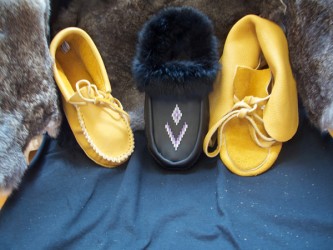Article Origin
Volume
Issue
Year
Sean and Heather McCormick, a brother and sister Métis team from Winnipeg, are passionate about Aboriginal handcrafted products. Their passion has become a business and their business is selling high quality mukluks and moccasins worldwide.
It was an interest plucked from their mother’s Métis background, which set them up with a passion for the past.
And how did they happen to target mukluks and moccasins; footwear that Aboriginal people have been wearing since the mists of time?
It began back in Brandon, Man. in 1990 when Sean was 23. He had some past experience managing a tannery and he also took part in an (now-defunct) entrepreneurship program for Aboriginal youth where he developed business plans.
From the tannery, he became involved with Aboriginal moccasins. Determined to let the world know more about this unique footwear, and with his sister, Heather, now working with him, the brother/sister team established a trading post in Winnipeg. There Aboriginal artisans traded handmade mukluks and moccasins for the McCormicks’ tanned leather skins and furs.
Fascinated by this footwear, that was both authentic and functional and which connected their present with their past, they began manufacturing their own moccasins and mukluks from new materials, and in 1997 registered a Canadian corporation.
Their moccasins and mukluks are specially designed for cold weather in either a rural or urban setting, and are made of 100 per cent leather—deer, moose, cowhide and suede.
The footbeds are sheepskin for its unique insulating qualities and the soles for urban settings are flexible Vibram, embedded with Aboriginal symbols of turtles, prairie grasses, and tipis.
They are designed by Cree artist Heather Steppler, a Fine Arts graduate, who says that she gets her inspiration for her footwear designs from Aboriginal legends.
Business continued to grow and, according to Sean, he soon needed to expand. He shopped his ideas of enlarging his operation and he is quoted as saying, “somehow I talked someone into lending me some money.”
The company continued to be self-funded until July 2010, when the CAPE Fund (Capital for Aboriginal Prosperity and Entrepreneurship) was established.
This $50-million private equity fund, launched by former prime minister Paul Martin and 21 partner companies, promotes Aboriginal entrepreneurship. Its policy is to maintain investments for about five to seven years with the ultimate goal of transitioning the equity back to the Aboriginal owner.
The investment from the fund, an amount was not disclosed, but Sean says, ‘it was in the millions,’ helped the company beef up its inventories and hire and train the company’s Aboriginal staff.
Currently their 12,000 square footwear factory in Winnipeg employs 50 Aboriginal workers that turn out 200 pairs of footwear a day. They are then sold to 800 retailers in 22 countries worldwide, including Japan, Sweden, Russia and Italy. Most of these sales occur between September and December.
Very much the entrepreneurs of the 21st century, they also sell through the Internet with detailed web exposure, using accurate descriptions, pictures and prices for each style of footwear. All purchases come with a Certificate of Authenticity.
Paralleling their extensive mukluk mocassin business, the brother/sister team developed their Storyboot collection to keep traditional knowledge of the ancestors alive.
A Storyboots’ artist designs a limited edition boot using both Cree traditional geometric beadwork and floral designs introduced by Roman Catholic missions in the early 19th century. Then the boots are duplicated and manufactured as limited editions.
Their artists become business partners and their limited edition museum quality footwear is sold on a fifty- fifty basis, sharing revenues between the artist and the company.
Edna Nabess is one of those artists who started making moccasins for Manitobah Moccasins with knowledge she learned from her mother and grandmother. Now she has her own store in Winnipeg, Cree-ations, where she sells Manitobah Mocassin products, fringed dresses and First Nation accessories.
Additional products are added to Manitobah Mocassin’s inventory when they meet the standards of the owners. Additional products include deerskin purses and fringed gauntlets similar to those worn in pictures of the explorer Alexander MacKenzie in 1789.
From their simple beginnings, these Canadian products have hit the fashion world and are featured in high fashion magazines and sold in high fashion stores around the world.
Paralleling their business, the company is very much involved in giving back to their community by supporting CAHRD (Canadian Aboriginal Human Resouce Development) program.
Heather McCormick states, “Stitch by stitch, bead by bead, we tell the story of our people.”
- 12323 views

